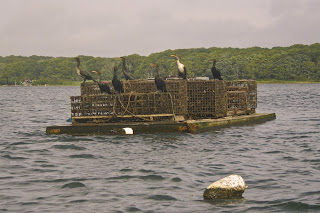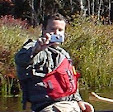 |
Point Judith Light and Coast
Guard Station from Camp Cronin |
It was too windy to paddle, so I headed over to Camp Cronin to get some pictures of the waves. I ended up walking up the beach to the Point Judith Light.
The Point Judith is located on the west side of Narragansett Bay and the eastern end of Block Island Sound. The confluence of these two waterways makes this a busy area for boat traffic, and there have been many shipwrecks over the years due to a treacherous ledge and frequent fog.
 |
Point Judith Light with the oil house
and fog signal house |
The first lighthouse was built on Point Judith in 1810. This wooden tower was destroyed in a severe hurricane in 1815. A 35-foot stone lighthouse was erected in it's place the following year. The new tower had a revolving light, which differentiated it from the nearby Beavertail Light.
In 1857, a new 51-foot octagonal brownstone tower was built. The upper half of the tower was painted brown and the lower half white. The oil house was added in 1917, and the fog signal house was added in 1923.
 |
Wave breaking on the East Jetty
of the Harbor of Refuge |
Even with the light, wrecks continued to occur with regularity in the vicinity of Point Judith. In 1890, work was begun on over 3-miles of stone
jetties to provide a secure breakwater refuge for ships. The east and west jetties were completed in 1890, and the Harbor of Refuge was completed in 1910 with the construction of the V-shaped center jetty.
The old lifesaving station was destroyed in a 1933 fire, and the existing Coast Guard station building was constructed in 1937. The station’s boats are kept in the Port of Galilee.
 |
| Point Judith Coast Guard Station |
Links:











































